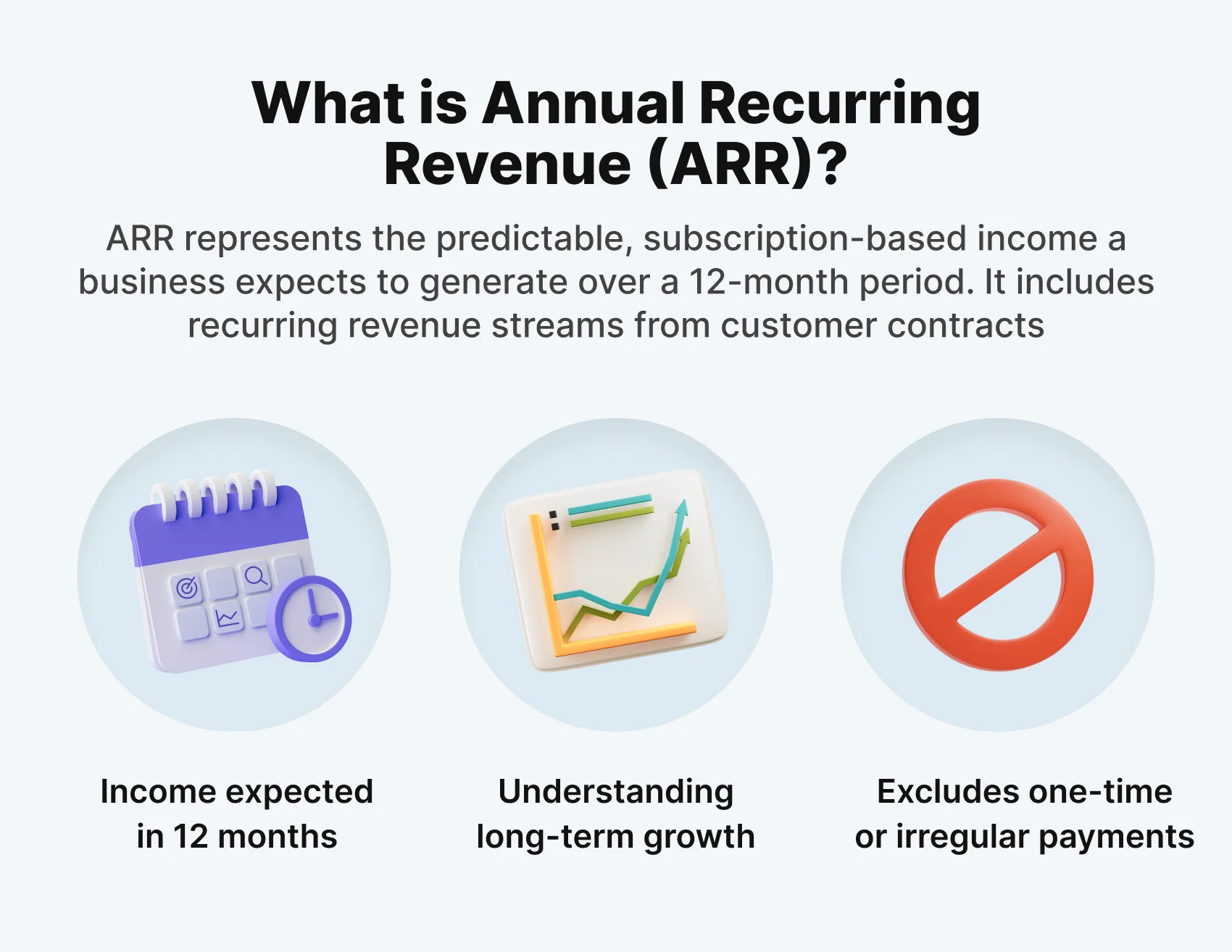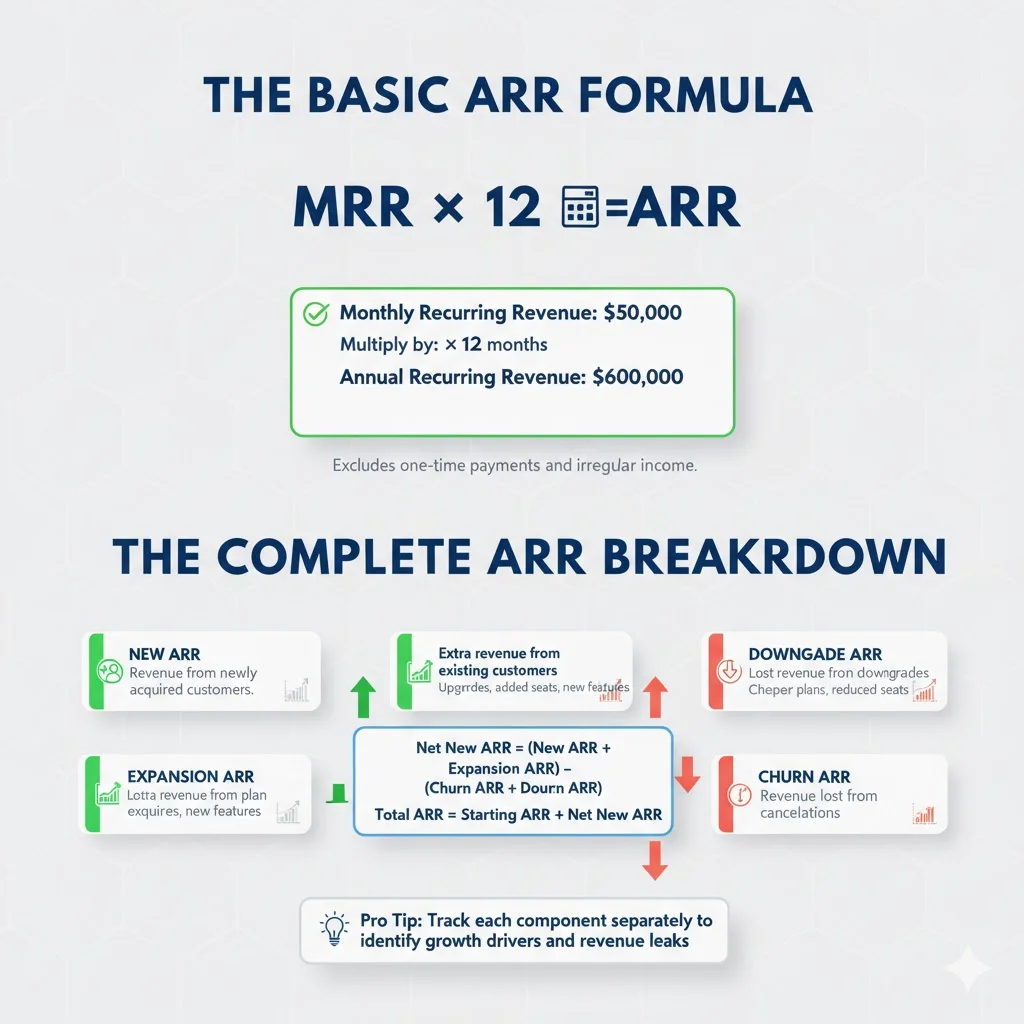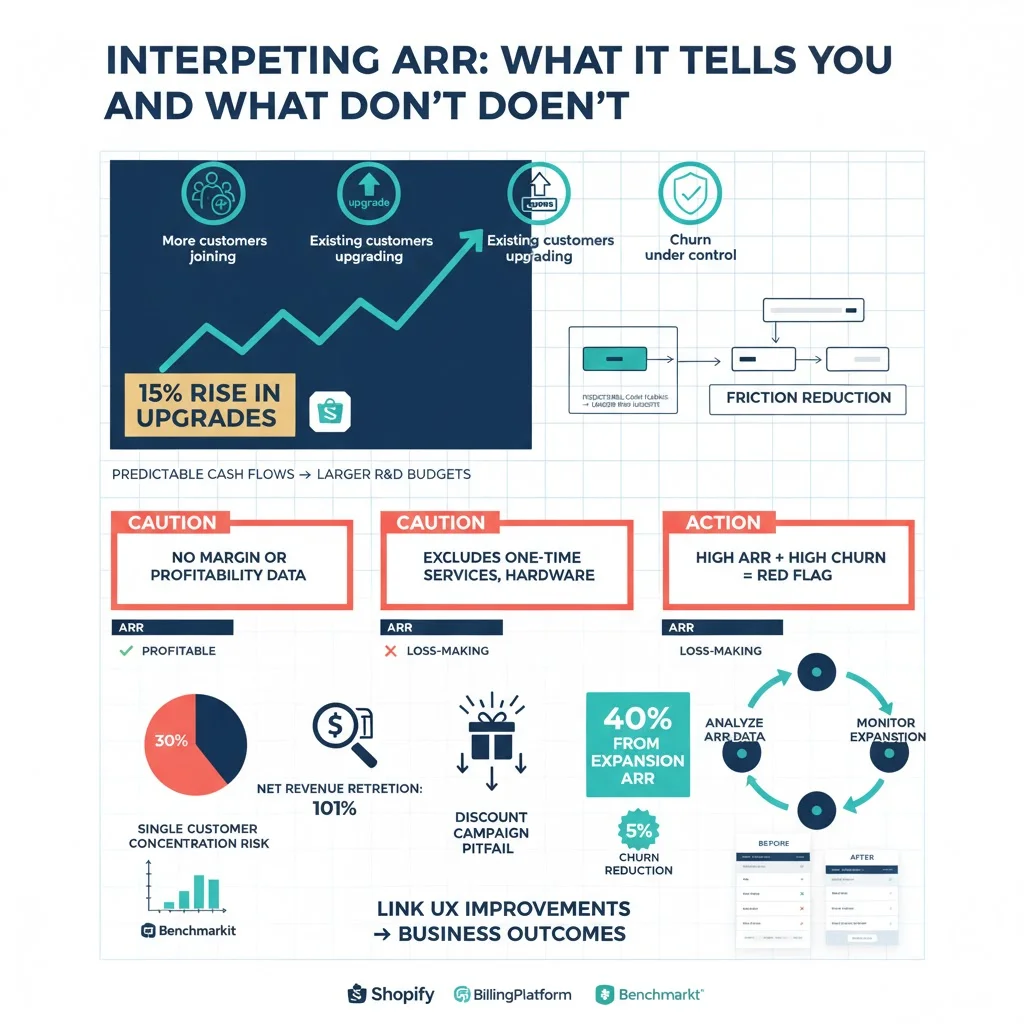What Does ARR Mean? Guide (2025)
Understand the meaning of ARR (Annual Recurring Revenue) and how it reflects the health of subscription‑based businesses.

When you work on design, product or technology at a young company you quickly learn that most board decks and investor updates include acronyms. ARR comes up a lot. People toss around statements like “we’re at $500k ARR” or “our ARR growth is slowing,” but few stop to unpack the term. At Parallel we see teams who build great products yet feel uneasy when finance asks about recurring revenue.
This article answers the question what does ARR mean, shows how to work it out and explains why it matters to people outside the finance team. We’ll look at definitions, formulas, examples and pitfalls, and we’ll link them back to product strategy and user experience decisions. By the end you’ll be able to interpret an ARR number and use it to guide design and product work.
What ARR stands for?
ARR stands for Annual Recurring Revenue. It’s a measure of the predictable income a company earns from customers on subscription or contract terms that renew on a yearly basis. In other words, if you ask what ARR means, the simple answer is: it’s the amount of revenue you can rely on each year from continuing subscriptions. The word annual emphasizes that this figure looks at twelve‑month periods, while recurring means it excludes one‑off fees or irregular sales. This focus on committed, repeatable payments is what makes the metric useful to investors, planners and product leaders.
A straightforward definition
An easy way to define ARR is to say it’s the amount of subscription‑based revenue a business expects to earn in the coming twelve months from its existing contracts. To keep the number meaningful we exclude implementation fees, equipment sales or other non‑recurring charges. Because ARR looks ahead, not back, it is built on assumptions about renewal and retention: we assume customers will continue paying unless we see signs of churn. This makes the figure a planning tool rather than a historical report.

What it means in everyday startup terms
For a product or design leader, hearing “we’re at $2M ARR” signals the company has $2M in predictable subscription revenue per year from its active contracts. That number is not just “how much we invoiced last year.” It represents the revenue floor we expect going forward if customers stick around. Founders and product managers use ARR as a cadence measure: it shows how fast the business is growing, whether pricing or packaging changes are working and whether customer retention is healthy. When someone asks what ARR means in a design review, we answer that it’s the base revenue tied to the experience we create; changes in onboarding, upgrade flows or support quality will directly affect it.
Why ARR matters for startups and product/design teams

1) Predictability and planning
Recurring revenue makes a young company less dependent on one‑off deals. It gives the team more stable cash flow and allows better forecasting. Shopify’s guide on annual recurring revenue notes that executives rely on ARR’s high degree of predictability for decisions about spending and expansion. For product teams, this predictability means you can plan longer‑term features, infrastructure investments and maintenance schedules without wondering if there will be cash next quarter. Knowing that your subscription base brings in $500k per year frees you to invest in a new onboarding flow or a refactor.
2) Linking ARR to other business metrics
ARR is not just a number on a spreadsheet. It ties into working capital and cash‑flow management. Because recurring contracts generate regular payments, they improve the accuracy of revenue forecasts and help companies manage obligations. The Benchmarkit 2025 SaaS report shows that expansion ARR now accounts for 40% of total new ARR across surveyed companies. That growth of expansion revenue highlights the link between product improvements and cash inflows: adding features that encourage upgrades directly lifts ARR and, in turn, helps with cash planning. The same report notes that research and development spend averages 34% of revenue at private SaaS firms, evidence that predictable revenue lets teams reinvest heavily in product.
3) Use by investors and internal stakeholders
Investors see ARR as a shorthand for company value. A common valuation multiple divides enterprise value by ARR; a higher multiple suggests strong growth potential. In our experience, venture capital partners often ask “what does ARR mean in your context?” to ensure the team isn’t including one‑time consulting fees. They look at how new ARR, expansion ARR and churn balance out to understand retention and product‑market fit. The Benchmarkit benchmarks show net revenue retention hovering around 101%, signalling that retaining and expanding existing customers is becoming more challenging. This metric is the flip side of ARR: it shows whether your existing base is growing or shrinking. Product and UX teams can’t ignore it because churn eats into ARR and upgrades grow it.
4) Why startup teams outside finance should care
Many of the factors that drive ARR live in product and design. A confusing upgrade path, a poorly designed renewal email or a clunky onboarding flow can push customers to downgrade or cancel. Conversely, adding features that encourage upsells can boost expansion ARR. The people designing and building the product control those levers. If you’re a designer and you wonder what ARR means for your work, it’s the signal that retention and upgrades are crucial metrics, not just conversion on day one. Founders and PMs use ARR when speaking to the board; understanding it helps you speak that language and advocate for user experience investments.
How to work out ARR
Basic formula
At its simplest, ARR can be worked out by taking your monthly recurring revenue and multiplying by twelve. If your subscription business has $50k in monthly recurring revenue, then ARR is $600k. Shopify explains that this basic method annualizes subscription revenue but should exclude irregular income.
A more complete formula
As your business grows, it helps to break ARR into components:
- New ARR – the revenue from newly acquired customers.
- Expansion ARR – the extra recurring revenue from existing customers who add seats, features or upgrade plans.
- Downgrade and contraction ARR – the lost recurring revenue when customers move to a cheaper plan or reduce seats.
- Churn ARR – the revenue lost when customers cancel their subscription.

Net new ARR is new plus expansion minus churn and downgrades. Total ARR at the end of a period equals starting ARR plus net new ARR. Breaking ARR down like this helps product teams see which customer behaviours contribute to growth and which erode it. In our own projects we’ve seen that emphasizing expansion ARR can generate meaningful gains: a cohort of customers might not grow in number, but if many upgrade after discovering a premium feature, ARR still rises.
Example for a startup
Imagine a company with 200 customers paying an average of $500 per year. The base ARR is $100 000. During the quarter, upsells add $20 000 of expansion ARR while cancellations remove $10 000 in churn. Net ARR is $110 000. This simple example shows why product improvements matter: if you improve onboarding and 10% more customers upgrade, expansion revenue could rise further. This also answers what ARR mean in terms your design team can act on—it’s a scorecard showing the impact of retention and upgrades.
Common pitfalls and what to exclude
It’s easy to mis‑state ARR. Here are common issues we’ve encountered:
- Including one‑time fees. The BillingPlatform guide stresses that one‑off implementation or training fees should never be included in ARR. They inflate the figure and mask the true predictability of subscription revenue.
- Ignoring multi‑year contracts. When a customer signs a three‑year deal for $120 000, ARR should show $40 000 per year, not the full contract value.
- Failing to normalize discounts. Promotions and discounts reduce annual revenue; the guide points out that subscribers paying $4 000 instead of the usual $4 500 need to be accounted for.
- Counting delinquent payments or free trials. Late or unpaid invoices and free trial periods should be excluded.
Connection to other metrics (MRR, ACV)
ARR is often confused with similar metrics. Monthly recurring revenue (MRR) looks at revenue per month; ARR is just MRR multiplied by twelve. Annual contract value (ACV) measures the value of a single contract per year and is often used in enterprise sales. Bookings represent all future committed revenue, including one‑off services; ARR focuses only on recurring income. Understanding these differences prevents miscommunication when investors or engineers ask what ARR means relative to MRR or ACV.
Interpreting ARR: What it tells you and what it doesn’t
What a high and growing ARR signals
When ARR climbs steadily it signals that more customers are joining, existing customers are upgrading and churn is under control. Shopify’s example shows that rising ARR is a sign of business momentum. In our client work we’ve seen that product improvements which reduce friction can drive a meaningful increase in expansion ARR. For instance, we redesigned an onboarding sequence for a SaaS tool and shortened the time to first value. The company saw a 15% rise in upgrades in the following quarter. Higher ARR also means more predictable cash flows, which can support larger R&D budgets and better service reliability.
What it doesn’t cover
ARR tells you nothing about margins or profitability. Two businesses with the same ARR can have very different cost structures. It also doesn’t include revenue from professional services, hardware or usage‑based fees unless they are contracted as recurring. The Shopify guide warns that one‑off sales should not be counted, and BillingPlatform stresses that one‑time transactions can’t be part of ARR. Nor does ARR guarantee that revenue will keep growing; a high figure with high churn is a red flag.
Startup risks around ARR
Over‑reliance on a handful of large customers can inflate ARR while hiding fragility. If a single enterprise accounts for 30% of your recurring revenue, losing it would be painful. Another risk is mis‑measuring: including non‑recurring revenue gives a false sense of security. The Benchmarkit data showing net revenue retention at around 101% reminds us that even modest churn can neutralize new sales. We’ve coached teams who celebrated a big ARR increase after a heavy discount campaign only to face a wave of downgrades when the promotional period ended.
How product and design teams should use ARR insights
Designers and product managers can use ARR data to prioritize features that improve retention and encourage upgrades. If expansion ARR accounts for 40% of new revenue, understanding which features drive those upgrades becomes critical. Conversely, if downgrade or churn ARR is high, it signals problems in the user experience or pricing. We once noticed that a confusing pricing page caused customers to leave; clarifying tiers reduced churn by 5% and raised net ARR. By asking what ARR means for each product decision, teams tie user experience improvements directly to business outcomes.

ARR in context: subscription models and beyond
Why it suits SaaS and subscription businesses
Subscription and SaaS companies depend on recurring income, so ARR is a natural fit. BillingPlatform notes that annual plans provide the most accurate way to measure new customers, churn, renewals and upgrades. The metric becomes a north star for growth and health; investors and analysts use it to benchmark performance across the industry. For product teams this means design decisions that encourage renewals have a direct impact on valuations.
Non‑SaaS uses and caveats
Other subscription models—streaming services, membership clubs, equipment leasing—also track ARR, but the picture can be messy when usage‑based or transactional revenue dominates. In those cases, you might use annualized run rate or other measures. The key is to include only predictable, recurring income. When asked what ARR means in a membership context, it still represents the committed payments you can expect over a year.
Working capital, cash flow and short‑term assets
ARR is a revenue metric, not a cash flow statement, yet it influences liquidity. Knowing that a large portion of income is locked in through subscriptions allows finance teams to plan working capital more confidently. A higher ARR often improves credit terms because lenders view recurring revenue as a stable base. In our experience advising startups, shifting 40% of customers from monthly to annual billing increased upfront cash, reducing financing needs. This directly affected the product roadmap— the extra liquidity funded a quality push that cut support tickets and churn.
Debt management, credit policy and financial ratios
Lenders and investors use ARR when assessing risk. A company with $5M ARR and net retention above 100% is seen as less risky than one reliant on project‑based income. Enterprise value to ARR multiples are common in valuation discussions. Product leaders may not care about multiples day to day, but understanding them helps you argue for investment in user experience—higher ARR and retention support a better multiple.
Working capital trade‑offs for product and PM leads
Pricing and billing choices influence cash flows. Annual plans paid upfront improve liquidity but may reduce flexibility for customers, while monthly plans spread cash receipts. We’ve seen teams test auto‑renewing annual plans with a discount; the upfront cash allowed them to invest in features that improved retention, which in turn grew ARR. Designers play a role here: a clear value proposition and frictionless upgrade path can make annual commitments more attractive. When you ask what ARR means for your product strategy, think about how pricing, billing cadence and user experience interact.
Best practices and tips for startups

1) Define ARR consistently
In the early days teams often use different definitions. Finance may annualize all revenue, while product counts only subscription fees. Decide which contract types count, how to treat multi‑year deals and how to account for add‑ons so that everyone uses the same figures. Consistent definitions prevent confusion when investors or team members ask what ARR means in a meeting.
2) Link ARR to product and UX metrics
Track cohorts: how many customers choose annual versus monthly subscriptions, and what their retention rates are. Measure expansion ARR per customer and look at which features drive upsells. UXtweak’s 2025 statistics show that improving user experience to increase customer retention by just five percent can lead to a 25% to 95% increase in profits. That link between UX and revenue growth makes it clear why designers should care about ARR.
3) Use ARR to inform roadmaps and prioritization
Features that reduce churn or encourage upgrades should be high on the roadmap. If the net new ARR is flat, dig into which parts of the product cause downgrades or cancellations. In one project we observed that customers struggled to add extra seats; making the process easier increased expansion ARR by 20%. By linking feature work to ARR movement, you make product priorities easier to justify.
4) Communicate ARR in language non‑finance teams understand
Visuals help. A stacked bar chart showing base ARR, new ARR, expansion ARR and churn makes the drivers clear. Narratives help too: “because we improved onboarding, we saw a 5% rise in expansion ARR” connects a UX change to revenue. Avoid jargon when explaining what ARR means to colleagues; tie it back to the experiences they build.
5) Beware of simplistic growth chases
A big jump in ARR from heavy discounts or one‑time deals can mask weakness. Focus on the quality of the recurring base: retention, average revenue per customer and product‑led upgrades. Benchmarkit reports that expansion ARR represents over 50% of new ARR for companies above $50M, signalling that sustainable growth comes from serving existing customers well. Chasing rapid ARR growth without regard for churn leads to a fragile business.
Conclusion
Annual Recurring Revenue is more than a finance metric. For early‑stage founders, product managers and designers, it’s a window into how the business earns money and whether customers are sticking around. We’ve shown that the question of what ARR means touches every part of the organisation: it’s the base against which you measure growth, the signal investors watch and the number that rises or falls based on user experience. Understanding ARR helps you connect design decisions—such as simplifying onboarding, clarifying pricing or adding value through new features—to tangible revenue outcomes. It also encourages cross‑team alignment: when everyone knows how new, expansion, downgrade and churn ARR work together, product discussions become grounded in shared facts. As you look at your own subscription model, take the time to define ARR clearly, monitor its components and use the insights to guide your roadmap.
Next steps
Start by reviewing your current contracts and pricing plans. Are you measuring only recurring income? Do you know how many customers upgrade or downgrade each quarter? Bring your product, design and finance teams together to ensure you’re speaking the same language when you talk about ARR. Then, look at one part of the user experience—onboarding, pricing screens, renewal flows—and ask: how could changes here lift expansion ARR or reduce churn? By working through these questions, you’ll make your product better and your revenue more stable.
FAQ section
1. What does the acronym ARR stand for?
It stands for Annual Recurring Revenue—revenue you can count on from recurring subscriptions each year.
2. What is the simple definition of ARR?
It’s the amount of recurring revenue a business expects to generate over the next twelve months from its current contracts, assuming renewals.
3. What does it mean when someone says “ARR”?
It means the recurring revenue baseline. So when you hear “we reached $5M ARR,” you know the company expects about $5M per year from subscriptions, excluding one‑off fees. It also hints at business stability and retention strength.
4. How is ARR worked out?
The simplest method is to multiply monthly recurring revenue by twelve, but a more complete approach is to add new and expansion ARR and subtract downgrades and churn. Always leave out one‑time fees and normalise multi‑year contracts.
5. Is ARR just last year’s revenue?
No. ARR looks forward. It’s based on the recurring revenue you expect to earn over the next twelve months from existing contracts. Last year’s sales can include one‑time items and may not recur.
6. Does usage‑based revenue count?
Only if it’s tied to a contract that includes a minimum commitment. Otherwise, usage fees are variable and should not be included.
7. What about professional services or hardware sales?
They’re excluded because they aren’t recurring. Including them overstates the predictability of revenue.
8. Is ARR recognised under accounting standards?
ARR is a non‑GAAP metric. It’s used for internal management and investor communications but doesn’t appear on audited income statements. That doesn’t diminish its value for planning—just be transparent about how you work it out.









.avif)



